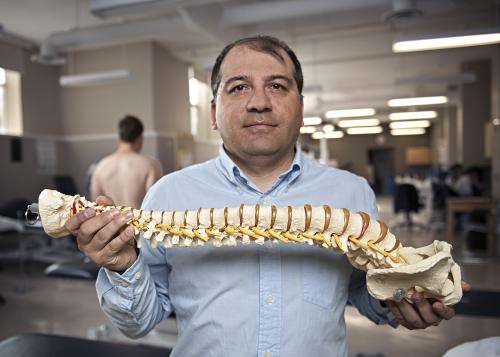Physiotherapy patient interaction a key ingredient to pain reduction, research says

How many times have you been to a physiotherapist where you've had more time in the waiting room than face-time with the physio?
Well, according to University of Alberta physical therapy PhD grad Jorge Fuentes, how a physiotherapist interacts with a patient verbally, through eye contact, body language and listening skills is almost as important as the treatment itself.
"The way we are applying treatment today is not the best approach," Fuentes says. "That might be the reason physical therapy interventions have such a modest effect for patients with chronic conditions. The therapeutic context, in which the interventions are delivered, matters. We have to take these non-specific factors into consideration."
For his PhD dissertation, Fuentes found that how physical therapists interact with patients—open communication, active listening, eye contact, facial expressions, tone of voice—plays a significant role in pain reduction. It's the first time that such non-specific factors of physical therapy treatment have been studied in a randomized controlled study.
In the study, 117 patients with chronic low back pain were split into four groups. The first received electrotherapy after limited, five-minute interaction with the physical therapist, who avoided eye contact and did not openly engage the patient. The second group received the same electrotherapy with enhanced interaction in which the physical therapist spent the entire 30-minute treatment with the patient and exhibited strong verbal and non-verbal communication.
The third group received the limited interaction while hooked up to electrotherapy, but the patient was unaware the device was not connected—what Fuentes calls "sham" treatment. Patients in group four received enhanced interaction with the same sham treatment.
Fuentes found that patients with enhanced interaction and real electrotherapy reported a three-point reduction in pain intensity on a 10-point scale, along with a two-kilogram increase in their pain thresholds—results he said that are considered clinically significant.
What was surprising, he said, was patients who received enhanced interaction during a sham treatment reported the next greatest improvement in pain intensity and threshold—even greater than the group that received actual treatment and limited interaction. The group that received limited interaction and a sham treatment reported the least change.
Fuentes says his findings, which he recently presented to strong feedback at the International Society for the Study of the Lumbar Spine Conference, are just the first step in understanding the importance of non-specific factors and optimizing treatment for patients.
Fuentes received his PhD from the U of A on June 5, capping off eight years of study that started with his master's in rehabilitation sciences. Next month he returns to his native Chile to help improve that country's clinical research and teaching in physical therapy.


















